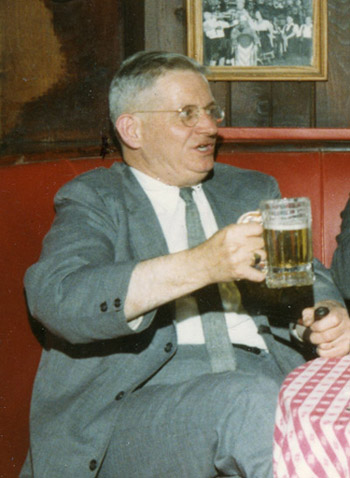Background on Samuel E. Murray

Samuel Murray, 1966
Samuel Murray was born on December 25, 1906, in Sedalia, Missouri, and spent most of his childhood there until his family moved to Brooklyn, N.Y., in 1916. He attended Columbia University where he studied engineering for four years of a six year program but did not finish as he became interested in other pursuits.
After college, Murray went to sea, serving as a yeoman engineer on both passenger and freight ships for various shipping companies, rising to the rank of Assistant Purser during his four year career. During the Great Depression he was unemployed for a time until 1932, when he landed his first job in the book industry as a sales representative for McGraw-Hill. He was with that firm for about four years until they shut down many of their operations. For the next couple of years he worked for a company that sold photographic services for high school yearbooks, until he returned to the publishing industry with G & C Merriam. His job there had him selling dictionaries to retail bookstores.
During this time of his life he was living in Bethlehem, Pennsylvania, where he met his wife, Josephine, at his aunt's home one day. Both said it was love at first sight and they were married in 1939.
At the start of the Second World War, Murray left the publishing industry and joined Bethlehem Steel Company where he was an inspector of large bombs before rejoining Merriam. Although he accepted a position in California, his stay was brief. Because Jo did not like it there, the couple moved to Wilbraham, Massachusetts, in 1943 and remained there for the rest of their lives.
Murray left Merriam in 1955 to become an independent publisher's representative for firms such as David McKay and the University of Oklahoma Press, covering a territory that included New England, New York, New Jersey, and Pennsylvania. He continued with that career until 1970 when he went full time into the antiquarian book business.
Murray's interest in books began as a child when his family moved to New York. Throughout his teenage years and into adulthood he visited many used bookstores and he rapidly began to accumulate a large collection of mostly non-fiction books about the sea, travel, exploration, and biographies. In 1970 his collection was overflowing, so he decided that his only option was to become a bookseller. He gave up his job as a publisher's representative.
All of Murray's business dealings were conducted out of his home in Wilbraham. He never advertised and he never issued a catalog. All of his business was by word of mouth, and in the early years most of his sales were to other book dealers whom he had met during his years of collecting. Later on, Murray's reputation spread and booksellers from all across the country, and the world, wrote or visited requesting books. Murray's style was easygoing and warm. He would invite prospective buyers into his home and spend hours with them going over his collection and having lively conversations about books in general. And at the end of the visit his wife, Jo, would cook a wonderful meal for everyone. People frequently wrote to Murray to say how much they enjoyed spending time at his home.
During his career as an antiquarian book dealer, Murray joined several professional organizations, including the Antiquarian Booksellers Association of America (ABAA), and he participated in many book fairs in the New England area, including all of the Boston book fairs. He also became a pioneer in the ephemera trade, being one of the first people to recognize the cultural and historical importance of ephemera. Murray was one of the founding members of the Ephemera Society of America (ESA) when that organization came into being in 1980, and he received the Maurice Rickards award from ESA posthumously in 1997, for distinguished service in the world of ephemera.
In 1984, Murray was stricken with myelofibrosis, a rare disease of the bone marrow. After many hospital stays and blood transfusions, the disease went into remission in 1986, but returned in early 1989. Samuel Murray died on June 4, 1989.

